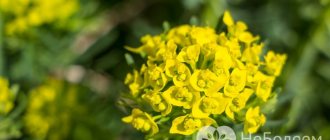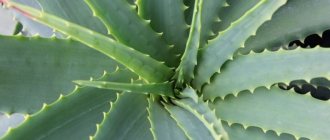Author: Elena N. https://floristics.info/ru/index.php?option=com_contact&view=contact&id=19 Category: Garden plants Published: February 03, 2019Last edits: August 14, 2021
- Growing conditions
- Liatris spicata
plant (lat. Liatris) belongs to the genus of perennial beautifully flowering herbaceous plants of the Asteraceae, or Asteraceae, family, growing naturally in Mexico, North America and the Bahamas. In their natural habitats there are about twenty species of liatris. The name of the plant is formed from two Greek words, translated meaning “smooth” and “doctor”. In our country, liatris flowers are sometimes called “deer tongue” or “cheerful feathers.” In garden culture, liatris is grown not so much because of the undeniable decorativeness of its candle inflorescences, but primarily for its amazing smell, combining the finest aroma of vanilla and notes of fresh hay. Humans are attracted to the smell of liatris, but moths cannot stand it: just one sprig of liatris placed in a clothes closet is enough for the harmful insect to leave your woolen sweaters alone.
Planting and caring for liatris
- Planting: early spring or autumn.
- Flowering: June-July.
- Lighting: bright sunlight.
- Soil: fresh, loose, moderately dry, nutritious.
- Watering: as needed.
- Hilling: regular, instead of loosening, since the plant has a superficial root system.
- Mulching: mandatory.
- Garter: tall varieties need to be tied to a support.
- Fertilizing: with mineral fertilizers three times per season: in the spring - nitrogen, in the summer - potassium-phosphorus.
- Reproduction: by seeds and dividing the bush.
- Pests: slugs, snails and mole crickets.
- Diseases: gray and root rot.
Read more about growing liatris below.
Outdoor care
Liatris is an unpretentious plant. To make it feel comfortable, the following care is necessary:
- watering in dry summers;
- mulching the soil;
- pruning faded inflorescences;
- getting rid of weeds;
- feeding
Watering and fertilizing
Since the plant is drought-resistant, watering is carried out only in hot, dry summers. During periods of heavy rain, drainage is done next to the bush, since stagnation of water has a detrimental effect on the root system.
During active growth and flowering, complex mineral fertilizers are added to the soil. In spring, fertilizing should contain a high nitrogen content; in summer, phosphorus-potassium fertilizers are used.
If the leaf blade turns pale in the fall, this is the first sign of nitrogen deficiency.
Mulching
After each irrigation, it is necessary to add a new layer of mulch under the bush. Since the root system of the perennial is superficial, loosening is not carried out and mulch comes to the rescue. It will protect it from exposing the roots, retain moisture and be an obstacle to weeds.
Trimming and tying to support
There are varieties that grow up to 1.5-2 meters, so staking such plants is necessary. To do this, pegs or a special support are installed next to the bush. If this is not done, the inflorescences may break under the weight of the flowers.
Another very beautiful flower: night beauty. Read.
To ensure long flowering and a decorative appearance, all faded inflorescences are removed in a timely manner. After this, the liatris is prepared for winter. It is cut off at the root and covered with a layer of mulch of 10–15 cm so that the tubers can withstand severe frosts well. Since temperatures below 5 degrees can cause irreparable harm to the plant.
Botanical description
Liatris flower is a perennial rhizomatous plant with simple or branched erect stems, densely foliated alternate or whorled pointed linear leaves. The tuberous roots of Liatris, similar to bulbs, are connected to each other by thin roots. With the right location and good care, the height of liatris can reach two meters. Tubular reddish-purple, violet-purple, pink, red and white flowers form baskets, which in turn are collected in spike-shaped or racemose inflorescences up to half a meter long.
Liatris blooms in summer, and unlike other flowers, liatris begins to bloom from the top, not from the bottom, of the inflorescence. Liatris fruits are oblong ribbed achenes covered with hair. Liatris is used in landscape design both as a solo plant and in combination with other flowers - gypsophila, brunnera, verbena, phlox, armeria. Liatris flower stalks stand well when cut - up to ten days, and the dried inflorescences are used to create winter bouquets.
2.Flowering time
Flowering in the middle zone occurs in the second half of summer and lasts until autumn. In more southern regions, buds will form earlier and flowering will occur in late June - July.
The first buds open approximately 3 months after planting the tuber. Unlike most plants, the opening buds descend from the tops of the flower stalks to their bases. The flowering period takes approximately 3 - 4 weeks.
↑ Up,
Growing Liatris from Seeds
Liatris is propagated by seed seedlings and without seedlings, but the plant is so life-loving, cold-resistant and unpretentious that it makes no sense to waste time and effort growing seedlings. Seeds are sown before winter or early spring directly into open ground, since they are not afraid of frost, but before sowing, the seeds need to be soaked for half a day in a humate solution.
- Why do seedlings stretch, and how can the situation be corrected?
The soil is first dug up with organic matter, adding a bucket of humus to the soil per square meter of land; grooves 1-1.5 cm deep are made for the seeds. The seeds are evenly distributed along the furrow, sprinkled with soil on top and watered. However, a gardener who prefers to grow liatris with seeds should know that the plant reaches full growth and full flowering only in the second or third year after planting. In addition, liatris produces abundant self-seeding in the fall, so in the spring all that remains is to thin out the seedlings.
5.Reproduction
There are several ways to propagate liatris - the flower can be grown from seeds or young plants can be obtained through division.
5.1.Growing from seeds
Liatris can be grown from seeds; this method will take a significant amount of time, but will save money on purchasing planting material. From one bag of seeds you can get several dozen bushes at once. The first buds will decorate the plants. grown from seeds only in the second or even third year.
It is not advisable to use personally collected seeds for propagation - varietal characteristics may not be preserved with this method of propagation, and the flowering of the resulting plants may not be as abundant and long-lasting.
It is interesting that if there are already liatris bushes on the site, then under them you can find self-seeding plants, from which it is enough to select and plant the strongest specimens.
↑ Up,
5.2.Sowing seeds
Sowing seeds can be done at home for seedlings or in open ground immediately after the snow melts, in early March. The seeds tolerate cool temperatures well and are not afraid of night frosts.
Sowing seeds in open ground in winter also brings good results. This method allows the seeds to undergo cool stratification in a natural way. The timing for sowing should be chosen so that the first shoots do not have time to appear before the onset of winter. Approximately in the middle zone, seeds should be sown in the second half of October.
Germination is quite long and the first shoots may appear only a month after sowing. Fresh seeds sprout the fastest - they only need about 3 weeks to germinate; the last sprouts may appear from the ground 1.5 months after sowing the seeds. If you keep the seedlings cool, at a temperature of about 5 - 7 degrees Celsius, the germination period can be reduced to 2 weeks.
↑ Up,
In order to increase germination, planting material should be kept for 1 - 1.5 months in cool conditions - stratified. The first to appear are oblong-oval cotyledon leaves, and then linear true leaf blades are formed.
Most often, the seeds are sown directly into the garden, since even when seedlings are grown, flowering will still occur only in the second year. For planting, a small area is cleared and loosened, and at night the planting material is soaked in warm water with the addition of growth hormones.
↑ Up,
Planting material is sown in shallow grooves and covered with a layer of soil about 0.5 cm thick on top. Since the shifts are quite large, it is easy to leave a distance of about 3 - 4 cm between them when sowing. Water the area with seedlings with warm water.
If sowing is done for seedlings, then a layer of drainage is poured into special boxes and filled with nutritious soil based on peat and river sand. The seeds are laid out on the surface of well-moistened soil and simply pressed into it.
Keep the seedlings at a temperature of about 20 degrees in a place with diffused light, without direct sun, covering the top with a transparent lid. With the emergence of seedlings, the shelter is removed, and the temperature in the room is lowered to 16 - 18 degrees, hardening the seedlings.
↑ Up,
5.3.Caring for seedlings
When grown in open ground, as seedlings appear, they are thinned out, leaving only the strongest specimens. The weaker ones can be carefully selected along with the root ball and planted in a new location.
The distance between young bushes can be 7 - 10 cm. When the plants get stronger closer to autumn, they are planted in a permanent place.
If the seedlings are grown at home, then the bushes are plucked from the boxes into separate pots when the first 2 to 3 true leaves appear.
↑ Up,
7 - 10 days after diving, the plants are fed for the first time with a very weak solution of nitrogen fertilizers.
Since there is often not enough light in the premises, and seedlings require 14 hours of daylight for good development, it is worth organizing artificial supplementary lighting for the plants using LED or fluorescent lamps.
You can plant in small peat pots - in this case, the seedlings are planted in the garden directly in them.
↑ Up,
5.4. Transplantation and division of liatris
Replanting and dividing adult bushes should be done every 4 years, since with age the middle of the plants may become bare, the bushes will fall apart and become ugly in appearance. Division will contribute to the rejuvenation of such specimens.
The transplant is carried out at the beginning of autumn - by this time the bush should have completely bloomed and at the same time there will be time for the transplanted plants to adapt to the new place before the onset of winter. You can also divide and replant in early spring, when the first shoots appear.
↑ Up,
The bushes are dug up and shaken off any remaining soil. Division can be done simply by pulling the bush in different directions. It is worth remembering that in each obtained part there should remain several nodules and well-developed shoots. The cuttings are planted in the garden, leaving a distance of about 35 cm between them, sprinkled with soil and watered abundantly.
Flowering plants should not be disturbed by replanting and dividing - they spend a lot of energy on forming buds and after replanting they can take a long time to grow.
↑ Up,
5.5.Separation of daughter tubers
The most common and easiest method of reproduction. When digging up bushes in the autumn months, several small daughter nodules can be found around each mother tuber. The nodules are separated, cleared of soil and dried. Store the tubers in a cool and dry place until spring.
↑ Up,
Planting Liatris
When to plant
The easiest way to propagate the perennial liatris is by vegetative means. If you already have liatris growing on your site, you can get planting material in August or September by dividing the liatris tuber into parts. Planting material is also sold in flower shops. But first you need to choose a site where the plant will grow comfortably. An open sunny place is suitable for liatris. Direct rays will not harm it, and Liatris is indifferent to high temperatures, so it will withstand the July heat.
The soil is preferably loose, nutritious and well-drained: what liatris is afraid of is water in the roots, from which its root system quickly rots, so heavy damp substrates and areas in lowlands, hollows and in places with soil close to the surface are not suitable for it water Liatris is planted in early spring or autumn.
How to plant
Tubers, depending on their size, are planted to a depth of 3-10 cm, keeping a distance of 15-20 cm between specimens. After planting, the liatris is watered, then the area is mulched with humus.
Alba, but not Jessica
For the garden, Liatris spicata "Alba" is a real "bride". When a light breeze begins to disturb the delicate white panicles, the flowerbed turns into the train/veil of a wedding dress. Such snow-white decoration is worthy only of a world-class actress. Flowering period is from late June to August. The stem rises to almost 100 cm above the ground.
The tubers of the variety are very close to the surface. During rains/showers, the soil may be washed away. Therefore, it is necessary to periodically hill up the bushes.
Flower growers advise covering the rhizomes with leaf humus (12 cm). It will serve as both fertilizer and reliable support for the plant.
Liatris care
Growing conditions
Caring for a liatris flower consists of watering it as needed, removing weeds, and periodically hilling up the bushes instead of loosening the soil, since the root system of the plant is superficial and can be exposed during prolonged rains. For the same reason, there is a need to add soil to the site. Tall liatris flower stalks sometimes have to be tied to a support. Do not neglect mulching the area, which, by protecting and nourishing the roots of the plant, significantly reduces the labor intensity of caring for liatris.
In addition, liatris needs to be fertilized with mineral fertilizers, which are applied three times per season: in the spring the plant is fed with nitrogen fertilizer, in the summer with potassium-phosphorus fertilizer. It is also necessary to prune the wilted inflorescences of the liatris so that the plant does not lose its decorative effect and even after flowering pleases the eye with the bright greenery of its foliage.
- Cletra: growing in open ground, types
Transfer
Liatris transplantation in the fall is usually carried out simultaneously with dividing the tuber once every three to four years. Liatris is dug up, the bush is carefully divided into parts so that each division has a root collar with tubers, then the divisions are planted in holes at a distance of 25 to 40 cm from each other, deepening the tubers into the ground by 8-15 cm. A third of the hole is filled up humus, then supplement it with garden soil and compact it. After watering, the area is mulched with humus.
Pests and diseases
As you can see, planting and caring for liatris in open ground is simple and easy. Liatris is as unpretentious as it is resistant to diseases, but it can be harmed by mole crickets and snails. In the fight against them, a folk method is successfully used: a bottle with 100 ml of beer is dug into the ground at an angle of 45º so that the neck is 2-3 cm below the surface level, in a small hole. Mole crickets and snails crawl towards the smell of beer and end up in a trap. The complexity of the method is that the beer needs to be changed in the bait regularly.
Sometimes the plant begins to rot due to waterlogging. In this case, all rotting places on the ground part of the plant should be cut off, then the liatris is treated with a fungicide. If the cause of the disease is close groundwater or too heavy soil, you should think about changing the area for liatris.
Pest and disease control
Liatris has good immunity, so its only problem is rot due to stagnant moisture. Cut off the affected parts and treat the bushes with fungicides. If the problem is in the soil or groundwater, it is better to replant the plant.
Liatris is often eaten by mole crickets and snails. First, use mechanical traps or remove pests manually, and then treat the planting with insecticides.
Photo: giordanosgiftandgarden.com
Pushkinia (60 photos): types, planting and care in open ground
Types and varieties
Three types of liatris are grown in culture: spikelet, filmy and rough.
Liatris spicata
Native to southeastern North America. Its heavily leafy stems reach a height of only 50 cm. The leaves are linear. Small baskets of 8-13 tubular flowers are collected in spike-shaped inflorescences up to 35 cm long. Flowering begins in June or July and lasts 35-40 days. In culture since 1732.
The most famous varieties of liatris spikelet are Floristan Weiss, up to 90 cm high with white flowers, Floristan Violet, up to 80 cm high with purple inflorescences, Kobold - liatris up to 40 cm tall with pink-purple inflorescences.
- Miscanthus: growing in the garden, types and varieties
Liatris aspera
A rare species with small lavender-pink flowers, forming long fluffy inflorescences. The stem is up to 1 m high, the leaves are lanceolate and shiny. This is the tallest species among liatris. There is a variety with white inflorescences - White Spire.
Liatris scariosa
It is distinguished by wider leaves - up to 3 cm wide, its inflorescences are pink-lilac, dark in color. The Alba variety has white flowers, and September Glory is distinguished by large bright pink inflorescences and a meter-high peduncle.
Flower in landscape design
When planting a plant on a site, you need to choose the right neighbors. Pay attention to color, height and flowering period.
Snow-white and purple varieties will look harmonious with red-orange and lemon flowers. Red-violet inflorescences will look perfect against the background of soft white bells and soft pink mallow.
Low-growing varieties are used for planting in rocky gardens and alpine hills. Kobold is considered the most suitable. Planted in the background next to blue-gray fescue, it will shade and complement it with its lilac and purple inflorescences.
Interesting! We read about the amazingly beautiful freesia flower.
Choosing a place to plant on the site
To successfully grow a flower, it is important to choose the right place to plant it. It must meet all the requirements of the plant.
Thus, it is better to choose a well-lit place for planting liatris.
Long-term predominance of shade negatively affects the plant.
Liatris begins to develop more slowly, and the inflorescences become smaller, flowering is short.
Ultimately, this can even cause the death of the perennial.
In the selected area, the soil should be well-drained. It is strictly not recommended to plant a plant close to groundwater.
Heavy and clayey soils are also not desirable. Liatris does not tolerate stagnant water. A dry period would be ideal for it.
The flower begins to grow and bloom with bright colors.
Pink or purple "Flamingo"
A trip to Africa will be meaningless if the tourist does not see these stunning birds. You can create your own “continent of the future” (another name for this part of the world) with the help of the delightful variety of Liatris spikelet “Flamingo”. Amazingly, this variety comes in both hot pink and purple shades. In most cases, the latter option is more popular than the former. The flower may have received its name because of the shaggy ears that resemble the plumage of these African inhabitants.











